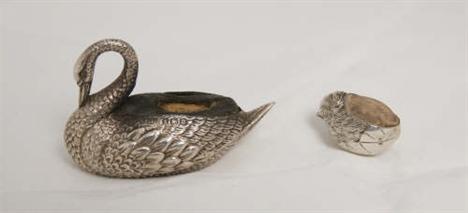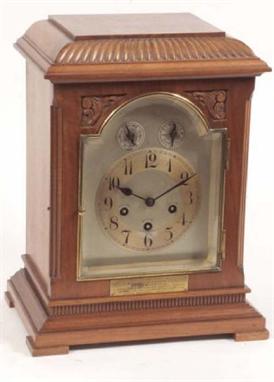We found 83806 price guide item(s) matching your search
There are 83806 lots that match your search criteria. Subscribe now to get instant access to the full price guide service.
Click here to subscribe- List
- Grid
-
83806 item(s)/page
Art & Antiques Reference Catalogue of the collection of pictures, works of art and decorative objects, the property of his grace the Duke of Hamilton. London, 1882, 8vo, 5 parts in 1 volume, illustrated, contemporary red cloth gilt, prices inscribed ink later, faded backstrip; Cushion, John & Margaret A collector's history of British porcelain. London, 1992, 4to, dustwrapper; Coysh, A.W. & Henrywood, R. The dictionary of blue & white printed pottery 1780-1880. London, 1982, 4to, 2 volumes, dustwrappers; Jackson, Sir Charles English goldsmiths and their marks. London, 1964, 4to. dustwrapper, fading; and 64 others (69)
A 1st quarter of 20th Century 9ct Gold Wrist Watch, Waltham, 553573, the jewelled movement with bi-metallic cut compensated balance, to a signed Arabic enamel dial, with outside minute track, sunk subsidiary seconds, and blued steel hands, in a cushion type case, with snap-on back and wire lugs, and fitted with a 9ct Gold open link bracelet with hook clasp, Birmingham 1925, width 1 ¼”
A 2nd quarter of the 20th Century Gold Plated Wrist Watch, unsigned, the Swiss 15 jewel movement with mono-metallic balance and blued steel hairspring, to a silvered Arabic dial, with outside minute track, sunk subsidiary seconds and blued steel dagger hands, in a cushion case with wire lugs and fitted black leather strap, width 1 5/16”
A 2nd quarter of the 20th Century 9ct Gold Wrist Watch, Rotary, the 15 jewel movement with spotted decoration and internal dust cover, to a circular silvered dial with applied gilt Arabic numerals, sunk subsidiary seconds and blued steel dagger hands, in a cushion case with snap-on back and fixed lugs, further fitted with a brown leather strap, Birmingham 1939, Maker’s Mark ALD, width 1 ½”
A 2nd quarter of the 20th Century Gold Plated Wrist Watch, Elgin USA 30801722, the striped movement with bi-metallic cut compensated balance and blued steel over coil hairspring to a signed Roman enamel dial, with outside minute track, sunk subsidiary seconds and blued steel hands, in a cushion case with snap-on back and fixed lugs, fitted with a black leather strap, width 1 7/16”
A late 19th Century Walnut cased Vienna style Wall Clock, the architectural pediment with half columns, centred with a female mask over further half ring turned columns, with cushion base and inverted finial, with composite Roman dial and outside minute track with gilt brass centre and blue steel hands, to a twin spring driven movement with anchor escapement and strike on a coiled gong, height 38”
A late 19th Century Walnut cased Vienna style Regulator, the scrolling architectural pediment with overhanging cornice, to half fluted Corinthian type columns, to a cushion base, with inverted acorn finials, to a two-part Roman enamel dial with outside minute track, subsidiary seconds and blued steel pierced hands, the single weight driven movement with anchor escapement, strike, height 54”
An early 20th Century Walnut cased Vienna type Wall Clock, the architectural pediment surmounted by a spread eagle over female masks and further lions masks, to half inverted baluster columns, to a cushion base with further inverted finials, to a two-part composite dial with Roman numerals, outside minute track and inside 24-hour track, signed Junghans, with black steel hands, to a Brass bob embossed pendulum, with anchor escapement, strike on a gong, height 42”
A late 19th Century Walnut cased Vienna type Wall Clock, the architectural pediment with overhanging cornice over half fluted Corinthian type columns, to a cushion base with inverted and ring turned finials, to a two-part Roman enamel dial, with outside minute track, subsidiary seconds and blue steel hands, to a twin weight driven movement with anchor escapement and strike on a coiled gong, height 54”
A late 19th Century Walnut and ebonised Vienna style Wall Clock, the shaped and scrolling pediment centred with a classical mask, over part reeded columns, single glazed door with cushion base and inverted finials, to a Roman dial with outside minute track, subsidiary seconds and blue steel pierced hands, to a twin driven weight movement with anchor escapement and strike on a coiled gong, height 51”
A late 19th Century Walnut and Ebonised Vienna type Wall Clock, the scrolling pediment centred with a classical mask over part reeded columns, to a cushion base, and single glazed door enclosing a two-part Roman enamel dial, with outside minute track and blue steel pierced hands, with spring driven movement and anchor escapement, strike on a coiled gong, height 32”
A late 19th Century Walnut and ebonised Vienna style Wall Clock, the elaborate architectural pediment with ring turned finials to an overhanging cornice, over half columns with cushion base and further inverted finials, to a two-part Roman enamel dial, with outside minute track, to a spring driven movement with anchor escapement, strike on a coiled gong, height 40”
An early 20th Century Walnut cased triple barrel Mantel Clock, the plinth shaped case with cushion top to an overhanging cornice and canted corners on a plinth base, to an arched glazed door enclosing a 6” silvered dial with subsidiaries for chime/silent and regulation over an Arabic chapter ring with blued steel spade hands, to a Junghans brass movement, with anchor escapement and strike on four rods and a blued steel coil gong, height 15”
A William IV carved rosewood library armchair by John Wilkie, London, with a leather upholstered back, arm rests and seat cushion, the seat with patent tin plate and spring slat supports stamped 'Wilkie Patent', the scroll and leaf carved arms to floret headed lappet tapering legs to brass caps stamped 'Cope and Collinson Patent' and brass castors. John Wilkie was a cabinet maker and chairmaker working between (1817-1840). In 1820 he was in partnership with William Cochran at 20 Nassau St., Middlesex Hospital. See 'Dictionary of English and Furniture Makers 1660-1840', by Geoffrey Beard and Christopher Gilbert.
An Edwardian dressing table jewellery box By W H Sparrow Birmingham 1902 the shaped gallery with pierced scroll work borders, the domed velvet cover lid hinged to revel the fitted interior, raised on four ball feet; together with a Victorian pin cushion and a trinket box -3 jewellery box 20cm wide
A French late 19th century parquetry rosewood and inlaid box the square slightly domed lid inlaid with a figure playing the violin within flowering rose branches, inlay comprising pewter, mother of pearl, bone and copper with crossbanding and cube parquetry throughout, the interior cushion lined 20cm wide
A George IV period rosewood side cabinet the moulded pointed arch superstructure with two graduated shelves on column supports, the top with a central edge above a cushion moulded frieze with a long drawer, above a pair of panelled cupboard doors enclosing a central associated shelf, flanked by columns to the corners and on a plinth base 112cm wide, 163cm high, 50cm deep
Miscellaneous rugby union memorabilia, comprising: an orange tray and cutting board; a Dubai Sevens rugby ball; & 1991 Rugby World Cup spectator’s cushion; a Gilbert brown leather rugby ball presented by the RFU to the sponsor Bowring, stencilled presentation inscription, with a wooden display stand (6)
-
83806 item(s)/page






































